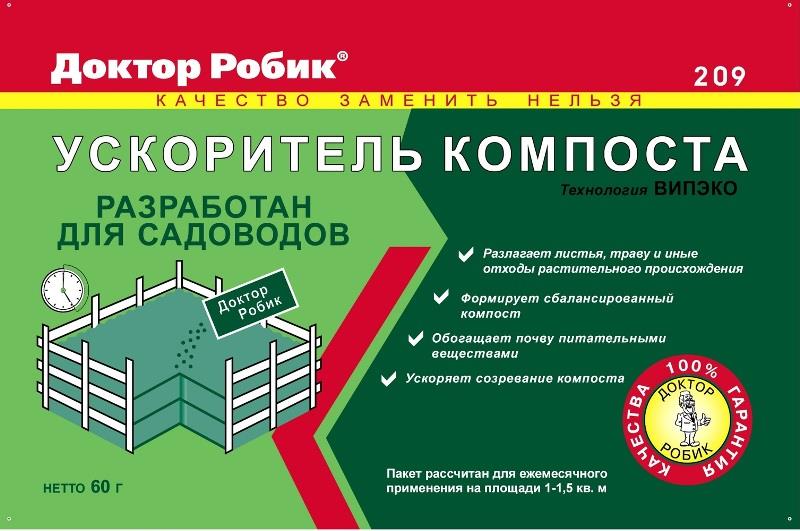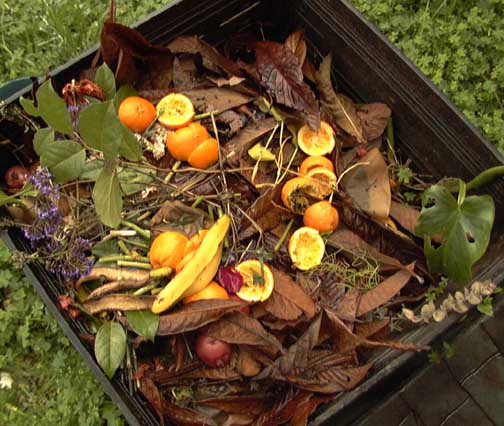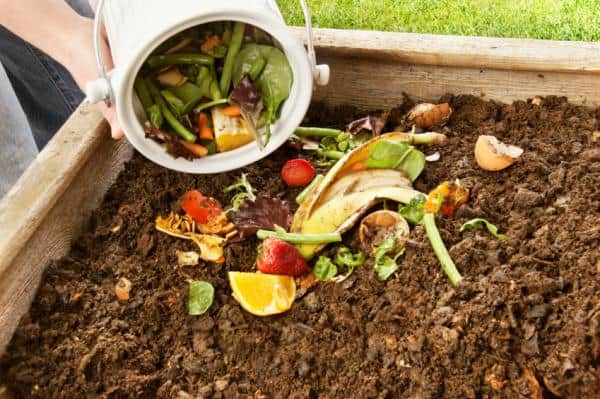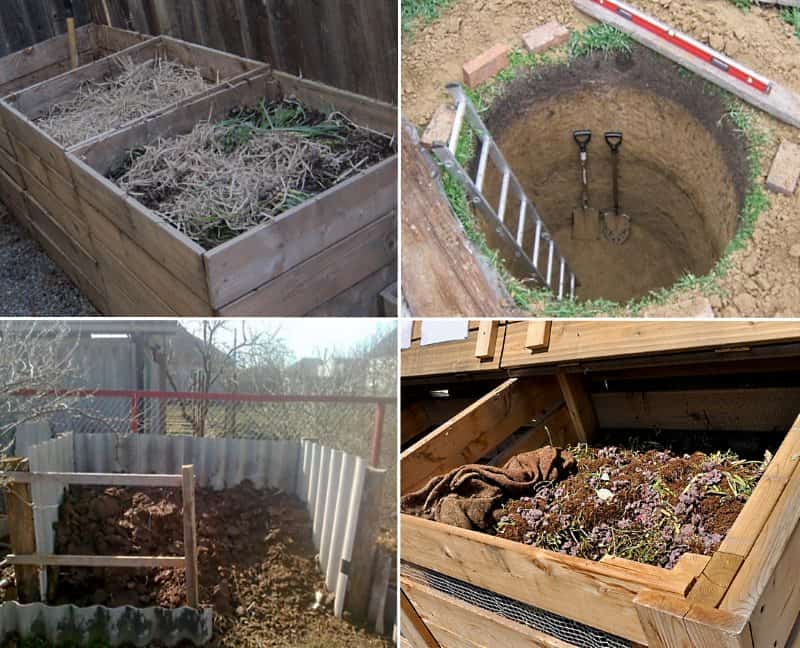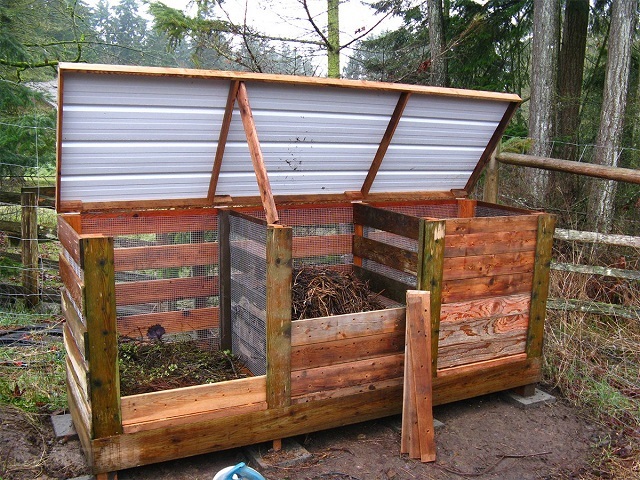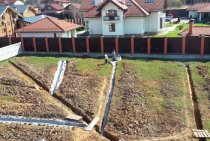Device and principle of operation
The compost pit in the country is a place for the disposal and natural processing of organic waste in order to obtain high-quality fertilizer. In order for the decomposition process to proceed quickly and correctly, it is necessary (figure above):
- maintain a high temperature regime in the warm season. This is achieved through size. In accordance with the norms, the pit for the formation of compost should not be less than 1 m³;
- provide access for air, moisture and worms. The correct compost pit is made with small gaps on all sides of the structure, thanks to which these requirements are met;
- split into two compartments. In the first compartment, it is recommended to place fresh waste, the processing of which takes about 2 years, and in the second part, gradually transfer partially decomposed masses.
What can be put in the hole? To get high-quality fertilizer that can be used to feed fruit and vegetable crops, you can put:
- dry branches;
- fallen leaves;
- cut grass;
- collected weeds;
- leftover vegetables (peel from potatoes, carrots, beets, cucumbers, apples, bananas, oranges, and so on);
- onion peel;
- eggshell.
Not recommended for composting:
- faeces of people and domestic animals;
- construction and household waste (plastic, printed matter, glass, and so on);
- sawdust;
- weeds that take root easily (loach, couch grass, sow thistle, and so on);
- remnants of protein food and oil products that attract rodents.
To accelerate the formation of compost, you can use specialized preparations, such as Doctor Robik, Baikal EM, Green Master, and so on. All drugs are used in accordance with the instructions on the package.
Means "Doctor Robik"
Tips from experienced gardeners
Firstly, in a compost pit, after a certain time, a high-quality natural fertilizer is formed that the plants need. Secondly, the problem of disposal of household organic waste disappears. With the creation of a compost bin, the question of finding a garbage container near the site will disappear by itself.
Location selection
Due to an unsuitably chosen place for the location of the pit, all work may be in vain. Before starting work, you should carefully inspect the area and analyze possible options.
- If the country house has a source, well, stream or any other body of water, then the distance from them to the compost storage should be more than 30 meters.
- If the site goes downhill, then the pit should be located below the level of the reservoir. Otherwise, the liquid formed during the decay of waste can poison drinking water.
- It is necessary to determine which direction the wind is blowing, that is, to calculate the wind rose. If the direction of the wind prevails from the side of the compost bin to the nearby site, most likely the neighbors will not be happy.
- It is advisable to abandon the location of the pit in a well-lit place. If overheated, the composting process will stop, so it is better to give preference to a shaded corner.
The two main conditions for the formation of high-quality compost are good moisture and friability. To maintain high humidity, frequent watering is used and the effect of a steam room is created due to covering with a film. For looseness, it is necessary to regularly shake the contents of the pit with a pitchfork. Do not refuse the help of volunteers. This refers to earthworms and microorganisms that process and decompose organic matter. So do not use impenetrable materials to block these creatures from accessing the content.
Arrangement of a compost pit
A convenient option for building a compost pit in the country with your own hands is a two-section hole.The waste of the first year is put in one compartment, the next - in another. In the third year, the earlier section is vacated. The resulting fertilizer is used, and the container is gradually filled with new waste.
But you can get by with a single-section option. In this case, there should be access to the resulting compost below, so that fertilizer can be collected with a shovel. The content falls by itself, and there is no need to loosen.
Construction technology
There are several ways to build a compost pit in the country. Each gardener independently selects the most suitable.
- Compost heap. Most often, its place in the garden plot is predetermined for it, where all kinds of organic residues are stored during the garden season.
- Compost pit. It is also called a warm bed. Organic material is laid below the level of the fertile layer, a bed is made on top, where seedlings are planted. This option has many advantages, one of them is that small seedlings (radishes, carrots, etc.) can be planted a month earlier.
- Compost heaps. This method is very convenient in that small heaps are distributed throughout the area in small quantities, and in the spring they are simply mixed together with the main soil. The rationalism of the method lies in the fact that the compost is located directly at the place where the seed will be planted.
- Closed building. First you need to dig a ravine. Standard dimensions: 0.5 meters deep, 1.5 wide, 2 long and 1 meter high above ground level. A frame is arranged along the perimeter (it is permissible to use boards, slate, iron sheet or build a concrete floor). The tree is pre-treated with compounds that will prevent the material from rotting. The frame is sheathed with timber, boards or lined with bricks. The roof can be hinged, that is, fastened with hinges on one side, or simply cover the building. The bottom does not need to be isolated, the access of oxygen and insects must remain free. You can cover the bottom with branches or boards. But this will already be considered the first layer of compost.
It is not enough to understand how to build a compost pit with your own hands, you also need to know how to properly care for the contents. Most importantly, fertilizer must be watered. The level of humidity must be sufficient for the effective functioning of microorganisms that contribute to the formation of useful organic elements. Watering is carried out with warm water. After moistening, the pile is covered with a film to form a greenhouse effect. For the fastest decomposition, a glass of sugar diluted in warm water with yeast is added to the fertilizer. This will increase the rate of compost maturation by several times.
What you need to know about compost
Nutrient fertilizer is able to reach the condition if it is warm and humid. To prepare the place of its "production", to provide a bunch of all the necessary requirements - the main task of the gardener. A sufficient amount of oxygen will allow you to get not a fetid heap of waste, but a real universal fertilizer.
- It is necessary to make sure that the main part of the pile is located above ground level. So the contents will be perfectly warmed up, provided with air. It will be convenient to water and loosen. The deepening of the pit should be no more than half a meter, and the surface part up to a meter. In width, the ideal parameters will be: 1.5x2 m.
- If there is a source from which drinking water is used: a well, a well, a spring, a territorial gap of at least 20 m should be taken into account. For greater certainty, if the site slopes, make the pit lower.
- Close up a pile of waste should be away from the house or recreation area, as an unpleasant smell will spoil the air and mood not only for the owners of the site, but also for neighbors. This issue must be approached responsibly, and choose a place that would suit everyone.
- To prevent the pile from drying out, do not place it in a sunny area. Well, if it were in partial shade, then the moisture necessary for the decay process would not evaporate quickly.
- In no case should the pit be close to fruit-bearing trees, this is fraught with their death.
What is compost made from?
Usually gardeners buy compost from garden stores. But with some effort and patience, you can also get "homemade" compost.
High quality compost is obtained from organic waste:
The more diverse the organic waste, the better the compost will turn out.
- fruits unsuitable for food (rotten), but not affected by diseases (berries, fruits, vegetables, cereals);
- used tea leaves and coffee grounds;
- straw and healthy plants (grass, flowers);
- foliage, branches, bark, roots and ashes of trees and shrubs;
- sawdust;
- needles;
- small pieces of waste paper (napkins, shredded newspapers, packaging, cardboard);
- fragments of natural fabrics (cotton, linen, wool, silk);
- second-year manure of herbivorous farm animals (cows, horses).
It is forbidden to throw into the compost pit:
- excrement of dogs and cats;
- bones;
- insect pests (for example, beetles - dung and Colorado);
- potato and tomato tops;
- tops treated with chemical fertilizers;
- perennial rhizomatous weeds;
- coal ash;
- synthetic waste (rubber, plastic and cellophane, scrap metal).
Waste can simply be piled in a heap in the most inconspicuous corner of the site, or you can prepare a neat pit for them, which even guests will not be ashamed to show.
Making such a compost pit with your own hands is not difficult. To do this, it is enough to use widely available materials and a little patience.
Arrangement and operation of a compost pit
When choosing a place where we would like to make a composter, several very important points should be considered:
The distance to the source of drinking water: a well, a well, a stream, a reservoir should be at least 25 - 30 m.
Also, if the site has a slope, the pit should be located below the well
Such precautions are necessary so that the runoff of decaying waste cannot enter the drinking water.
It would not hurt to take into account the wind rose, so as not to annoy yourself and your neighbors too much with an unpleasant smell.
It is better if the compost pit is located somewhere in the corner of the site, adjacent to a blank wall or fence
In addition, I want to clarify that in open sunny areas, the contents of the pit can overheat greatly, then the composting process stops, so it is advisable to shade the structure with trees. It is better if the compost pit is located somewhere in the corner of the site, adjacent to a blank wall or fence.
Let's also decide what can be thrown into the compost pit and what cannot.
Suitable for composting:
- Raw vegetables, fruits, berries, tea, cereals, coffee. Cleaning residues included.
- Hay, cut grass, straw.
- Leaves.
- Branches, bark, roots of shrubs of trees, slightly crushed.
- weeds.
- Wood ash.
- Needles.
- Napkins, cardboard, natural paper bags, shredded.
- Unpainted wood waste.
- Herbivore dung is the second year.
Not to be used for composting:
- Bones.
- Excrement of domestic animals. They may contain helminth eggs.
- Insect pests and their eggs.
- Plants affected by diseases (tops of tomatoes with late blight, pumpkin and cucumbers with powdery mildew, etc.).
- Plants from areas treated with herbicides.
- Inorganic waste: any plastic, iron, synthetic fabrics, rubber.
Non-compostable material should preferably be either incinerated or disposed of in a pit latrine if it is excrement.
The decomposition of organic matter is carried out by microorganisms and earthworms. Therefore, it is not necessary to isolate all the walls of the pit that are below ground level. If you dig a hole 50 cm deep and enclose it with impenetrable material, the worms will not be able to get inside. They will have to be settled on their own. The rules, as you can see, are quite simple, and the benefits of following them are extremely high.
A compost pit is that easy

It's no secret that the problem of waste is one of the most important in the conservation of the environment. But all waste is different and the process of their disposal takes place in different ways. Let's take a look at organic waste first. They are perhaps the easiest to make not only safe, but also useful.
What do we consider organic waste?
These are all food waste (except for large bones), vegetable waste from the garden, manure, ashes, soapy water.
Let's separate them and not mix them with others.
The simplest, easiest and most reliable way to dispose of organic waste is composting.
What is composting?
This is an accelerated decomposition process, in which conditions (temperature, humidity, oxygen) are created for the mass reproduction of numerous bacteria. It is they who recycle and make safe organic waste. If at least one of the conditions is not met, the process stops. Therefore, in order to successfully cope with the processing of waste, it is necessary to strictly comply with the conditions of composting.
One of the easiest compost making tools is a compost pit.
What is a compost pit?
Such a structure is easy to manufacture and can be placed on any garden plot. A hole is dug with a size of 1 m x 1 m (dimensions can be increased if necessary) and a depth of NO MORE THAN 20–25 cm (as the depth increases, the soil temperature drops and the processes of reproduction and vital activity of bacteria and, accordingly, the formation of compost) slow down sharply.
It is recommended to cover the pit with a lid that will prevent birds from picking up debris, spreading unpleasant odors and drying out the pit. For ease of use, a hatch can be made in the lid (if the pit is large, then two hatches).
It is very important that water does not stagnate in the pit, because. it blocks the access of oxygen
Therefore, a place for a compost pit should be chosen on a flat, not swampy area. If water stagnates in the pit, then it is necessary to make drainage.
Suitable for composting are organic household and garden waste, as well as minerals such as ash, sand, and soil. Additionally, you can use peat, bark, chopped branches and plants, as well as silt and algae. Compost forms faster when it is stirred. When loosening the inner layers and dense lumps, the access of oxygen to them increases, and the decomposition process is accelerated.
When watering the compost with soapy water, the content of phosphorus compounds necessary for plants increases in it.
Inorganic garbage (plastic bags, glass, metal waste) must not be thrown into the compost pit, because it is practically indestructible.
Subject to all the rules, compost in the pit is formed in 1.5–2 years.
To fertilize the soil, compost is covered from above with a layer of 5–10 cm, which corresponds to 5–10 m³/100 m².
We call on all residents and guests of Kizhi Island to respect nature and competent waste disposal.
Preventing disaster is much easier than dealing with unforeseen consequences!
Department of Nature of the Museum-Reserve "Kizhi", 2002
Compost pit organization rules at their summer cottage
When arranging a summer cottage for the preparation of organic fertilizer, several rules must be observed:
- The size of the box or recess should correspond to the volume of organic debris, which approximately accumulates over 2-3 years. The optimal parameters are 1.5 * 3 m and a depth of 1 m. It is more convenient to equip 2 pits and use them seasonally so that the organic matter has time to rot well.
- It is more practical to place a waste collection tank behind the yard so that it does not spoil the landscape. There should be at least 25 m to the drinking source on the site. If the site is located on a slope, then the organic reservoir is made below the source of the well so that effluents do not accidentally enter the water.
- A homemade compost box should not be placed in the deep shade of the garden, under such conditions the substance will rot longer.
- Experts do not recommend constructing a structure above 1.2 m, since it will be inconvenient to get humus.
General building requirements

To maintain a high temperature inside the container, a number of conditions must be observed. The volume of the composter must exceed one cubic meter. The gaps on the side walls are mandatory and are designed to provide humus with air flow. And the top cover or film will protect the compost storage from drying out.
Worms should be able to somehow get into the composter
To do this, it is important to ensure contact between the lower part of the structure and the upper soil layers. Earthworms and bacteria can enter holes
They contribute to the acceleration of putrefactive processes and loosen the compost.
We must not forget about laying drainage instead of the first layer of organic matter. The following materials can play the role of drainage in a standard organic composting bin: crushed sand, crushed stone, shells (an unusual choice, but why not if you live in a seaside area), geotextiles and coarse gravel.
To improve the aesthetic side of the composter, it will turn out by coloring its outer part. You can use alternative decor. It is acceptable to use painted shields, and if you are using a wooden box, you can wrap the compost bin with loach or other perennials;
There are special conditions for mounting the front wall. It should ensure that the compost is removed from the pit as needed. To do this, it must be made removable or opening. The most successful option is considered to be a hinged wall with a small lock on the opposite side.
Raw materials for compost
To obtain high-quality compost, you must use the right raw materials. What kind of waste can be taken out in a heap for subsequent decay? Suitable for composting:
- vegetable peelings;
- cores;
- rotten fruits (not affected by diseases and pests);
- sleeping tea and coffee cake;
- cut grass;
- paper products;
- dry foliage;
- roots, branches and bark of trees;
- unpainted wood waste;
- dried herbivore dung.
It is impossible to take out bones, excrement of domestic animals, fruits and plants affected by diseases and pests, as well as inorganic materials that cannot decompose in 1-2 years (plastic, rubber, metal, glass, etc.) into the compost heap.
Other ways to create a compost pit
In some cases, you can move away from traditional methods and get compost with less effort.
Plastic containers as a compost pit
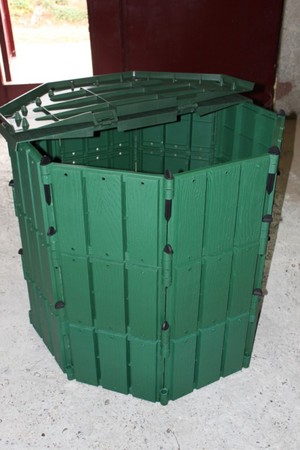
Although pits of this type are not without drawbacks: worms and bacteria will have to be added to them without fail. Otherwise, you will not be able to get high quality compost in the container.
Compost beds
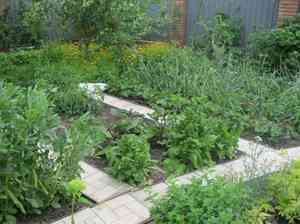
The method can save the summer resident from laborious work, which never ends on the plot. In this case, is it worth spending time and effort on transferring waste to a pile, given that subsequently the compost will still have to be sent to the beds?
You should also remember about the gas, the formation of which inevitably accompanies the process of making compost. To be honest, it doesn't smell that bad. If you decide to take waste to the beds, you will not encounter a similar aroma. Microorganisms in the soil will independently process the organic matter that has appeared.
To date, there are many methods that allow you to dispose of waste with minimal effort, having received considerable benefits from them in the form of compost. Everyone can cope with this task, for which you do not have to spend significant funds. In this case, the end result will fully justify the effort expended. In addition to keeping the area clean, you will increase your yield without resorting to not-so-harmful chemicals.
What is a compost pit for?
We know that during the summer season a large amount of organic waste accumulates, which includes food residues, weeds and cut grass, which are constantly removed from beds and lawns.
All this waste must be disposed of in one specific place, in a compost heap, which in two to three years will give you a high-quality product in the form of an excellent fertilizer.
Along the way, this will help get rid of unnecessary plant materials, your site will be clean and tidy, the waste will not have to be taken far beyond the garden.
The decomposition of plant waste in a natural way takes about 20 months, but if the process is artificially accelerated, it is possible to achieve a result in three months.
Tools and materials for work
A compost bin is often constructed from planks or timber.
For this you will need:
- circular saw, electric jigsaw, circular saw or ordinary hacksaw - for cutting wood;
- chisel;
- screwdriver;
- roulette;
- spirit level (or level);
- garden shovel or drill;
- hammer and nails;
- screws (ideally galvanized);
- metallic profile;
- boards from any tree species;
- dye;
- doorknobs and latches.
To protect wood from moisture and insects:
- moisture resistant enamel;
- varnish with antifungal impregnation.
A compost pit with concrete-filled walls will serve you faithfully for a long time.
For the manufacture of concrete you will need:
- river sand;
- crushed stone or gravel;
- cement;
- water.
Sometimes you don’t want to spend a lot of time and effort on making a compost pit. In this case, it is easier to purchase ready-made containers and barrels for compost made of plastic. Such composters have an attractive appearance, but will also cost more.
Benefits of a plastic composter:
- a sealed container prevents leakage and, as a result, contamination of drinking water;
- thanks to the ventilation system, the water in the container does not stagnate.
Choosing a place to build
When installing a compost bin or digging a full-fledged pit, you must remember about the sanitary conditions of installation
The pit should be located on a hill, not less than 20 meters from a source of drinking water or any other publicly important body of water
Rain streams should also not drain towards wells, wells and pools. The water that accumulates in compost bins is loaded with hazardous chemicals and can cause severe indigestion or even death.
The distance from residential buildings should exceed 10 meters (this will protect against characteristic unpleasant odors), proximity to orchards and shrubs with berries should also be avoided.
What about accessibility to sunlight? It is better to install the building in partial shade, otherwise the humus will have to be watered often.
To summarize all the rules for installing a composter listed above, it is best to install it in the backyard. This will not spoil the appearance of the site.
But we advise you to lay a path to it: it will hardly be convenient to walk with a bucket full of waste through an uncleaned area. In addition, it will turn out to use a much more convenient garden wheelbarrow.
Brief rules for using a compost bin
- We figured out the options for creating a facility for storing compost. But how to use it? First of all, you need to understand: any compost needs loosening. When turning the contents of the pit with a pitchfork, the elements of the compost will be mixed, and fresh oxygen will allow the organic matter to decompose faster.
- From above, an open container with compost should be covered with a dark film. What for? This will create a small greenhouse effect and raise the temperature in the compost pit. Also, the film will become a restriction on the growth of weeds, will contribute to the preservation of moisture. Covered compost matures about a week faster.
- Despite the properties of the film, you need to water the humus. The higher and more stable the moisture level, the more useful properties the fertilizer mass will retain. In overdried compost, decomposition processes almost completely stop. The optimal ratio of dry elements and wet elements was derived - five to one.
- Some organic matter and products can damage the consistency of the compost or attract pests to it. It is impossible to lay pesticide-treated plants, pet excrement, inorganic matter, fruit tree bones, tops affected by flora diseases, protein waste (they smell unpleasant).
- Monitor the presence of living organisms in the compost pit. Pests can encroach on it, but green manure plants can help against them. And in the list of useful creatures are bacteria and worms. Bacteria can be attracted by decaying organic matter. Worms can be added artificially, directly from the site.
- If you're worried about the rate at which organic tissue decomposes, try adding special preparations to the compost. The most suitable are Compostin (about 69 rubles), Baikal EM-1 (no more than 190 when ordering online) and Compostar (about 140 rubles).
If you follow all the above rules for installing and using a compost bin, stable care of the organic mass, you can get high-quality, environmentally friendly fertilizer.
And most importantly - it will cost the minimum amount of money, since all the elements of compost can be found in the wild or in the garden.
